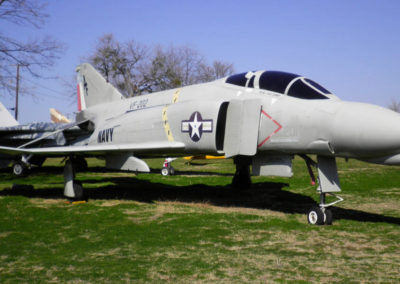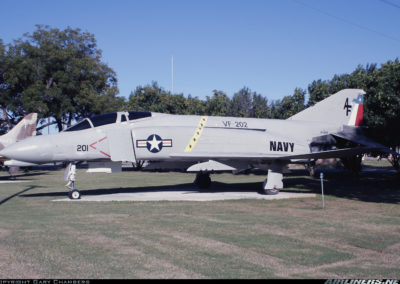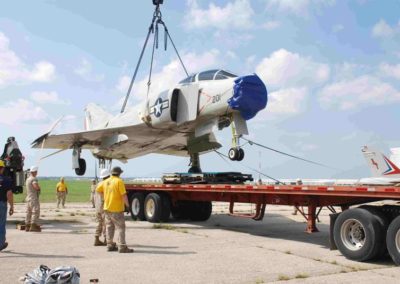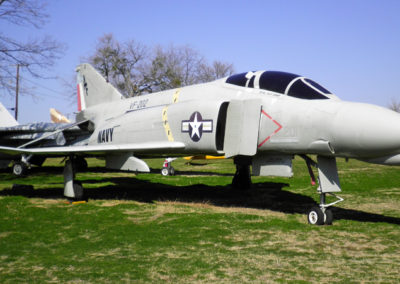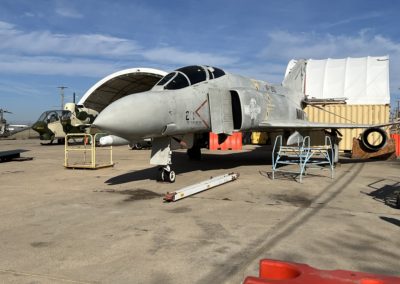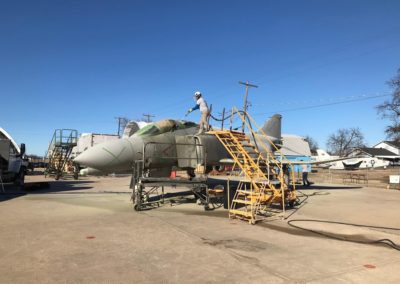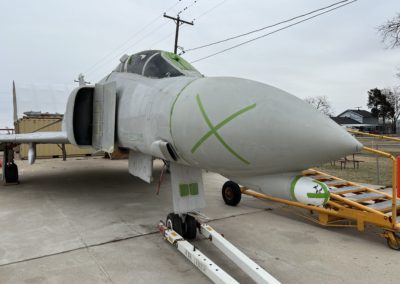F-4C Phantom II
The F-4 was operated by the USAF/USN/USMC at Carswell AFB and NAS Dallas. Fort Worth businessman H. Ross Perot, Jr. flew F-4s at Carswell AFB while serving in the USAF.
Warbird Overview
The F-4 was operated by the USAF/USN/USMC at Carswell AFB and NAS Dallas. Fort Worth businessman H. Ross Perot, Jr. flew F-4s at Carswell AFB while serving in the USAF.
ABOUT THE F-4C PHANTOM II
The F-4 was operated by the USAF/USN/USMC at Carswell AFB and NAS Dallas. Fort Worth businessman H. Ross Perot, Jr. flew F-4s at Carswell AFB while serving in the USAF.
First flown in May 1958, the Phantom II originally was developed for U.S. Navy fleet defense and entered service in 1961. The USAF evaluated it (as the F-110A Spectre) for close air support, interdiction and counter-air operations, and in 1962, approved a USAF version. The USAF’s Phantom II, designated F-4C, made its first flight on May 27, 1963. Production deliveries began in November 1963. In its air-to-ground role, the F-4 can carry twice the normal bomb load of a World War II B-17 Flying Fortress. USAF F-4s also flew reconnaissance and “Wild Weasel” anti-aircraft missile suppression missions. Phantom II production ended in 1979 after over 5,000 had been built — more than 2,800 for the USAF, about 1,200 for the Navy and Marine Corps, and the rest for friendly foreign nations.
Fact #1
This aircraft is a Vietnam War veteran that served for a time with the local 301st Fighter Squadron as a combat maintenance trainer. That is why there are so many patches on the airplane.
Fact #2
When the Air Force was going to dispose of it, the Commanding Officer of the Joint Reserve Base had it transferred to the Navy and had it refurbished in Navy livery to commemorate the Navy squadron that flew F-4s here at Navy Dallas and the JRB.
Fact #3
The 433rd TFS was the first Air Force squadron to drop Laser Guided Bombs, LGBs.
Manufacturer: McDonnell Douglas
Armament: Up to 16,000 pounds of externally carried nuclear or conventional bombs, rockets, missiles, or 20mm cannon pods in various combinations
Engines: Two General Electric J-79-GE-15s of 17,000 pounds thrust each
Max. Speed: 1,400 mph
Cruising Speed: 590 mph
Range: 1,750 miles with one 600 gallon and two 370 gallon external tanks
Service Ceiling: 59,600 feet
Wingspan: 38 feet, 5 inches
Length: 58 feet, 3 inches
Height: 16 feet, 6 inches
Weight: 58,000 lbs. maximum takeoff weight
The Fort Worth Aviation Museum has two F-4 Phantom-type aircraft. This one is the McDonnell Douglas F-4C-24-MC Phantom II, Air Force Serial No. 64-0825, c/n 1164. It was produced by McDonnell Aircraft in St. Louis, Missouri and was accepted by the US Air Force on October 7, 1965.
The aircraft was assigned to the 4520th Combat Crew Training Wing, Tactical Air Command, Nellis Air Force Base, Nevada, in October 1965. Six months later, in April 1966, the aircraft was assigned to the 4453rd Combat Crew Training Wing at Davis-Monthan Air Force Base in Arizona.
In November 1966, the aircraft went to the 366th Tactical Fighter Wing, Pacific Air Forces, Da Nang Air Base, Vietnam. The squadrons of the 366th were now all in Vietnam: the 390th Fighter Squadron (FS) was assigned to Da Nang Air Base, the 391st FS was at Cam Ranh Bay Air Base, with the rest of the wing at Phan Rang Air Base, Vietnam.
Pilots were frustrated by missed opportunities to shoot down enemy MiGs because the F-4C lacked a cannon and its missiles were ineffective at short ranges. So wing maintainers and aircrews modified the mounting of an external 20-millimeter Gatling gun pod on the F-4Cs used for ground attack for use in air-to-air combat, and in less than a month, starting on May 14, 1967, the wing’s pilots had scored four MiG kills. The gun pod innovation and the MiG kills that followed earned the wing the nickname it carries today, the “Gunfighters.” During this period, the wing earned a Presidential Unit Citation for shooting down 11 enemy aircraft in a six-week period and other combat actions.
It should be noted that not all the action was in the air. Starting with a Viet Cong rocket attack in February 1967 followed by similar attacks in July and September of that year and with increasing frequency thereafter, several ground personnel were killed and injured. The number of enemy attacks throughout the remainder of the conflict earned DaNang Air Base its well-deserved nickname: “Rocket City.”
In January 1968, the aircraft joined the 12th Tactical Fighter Wing (FTW) at Cam Ranh Bay Air Base. In March 1970, the aircraft joined the 479th Tactical Fighter Wing at George AFB, California. In October 1971, the aircraft was assigned to the 35th Tactical Fighter Wing at George AFB. In April 1972, the F-4 joined the 170th Tactical Fighter Squadron and 183rd Tactical Fighter Group, Air National Guard, at Capital Airport Air National Guard Station in Springfield, Illinois. In May 1984, the aircraft joined the 142nd Fighter Interceptor Group (FIG) at Kingsley Field Air National Guard Base at Klamath Falls Airport, Oregon; and the 301st TFW, Carswell AFB, Fort Worth, Texas (tailcode TH). In May 1987, the aircraft was dropped from the USAF inventory and declared surplus. The aircraft received a Navy paint scheme and became a display aircraft at Fort Worth Joint Reserve Base. The Fort Worth Aviation Museum received the aircraft in 2009. It is on loan from the National Naval Aviation Museum in Pensacola, Florida.
Phantom Air Force Scheduled for Hops & Props. It will be stripped and painted in the Vietnam livery colors. If all goes well, a centerline tank will be added and missile rails if found in time. It Is a big focus along with the TA-4j FOR Hops & Props.
Note: Scheduling is always a moving target depending on weather and workload. All schedules are subject to changes.
Become a Member!
FLIGHT SIMULATOR
HOURS
Saturday: 9AM-2PM
Sunday: 11AM-3PM
